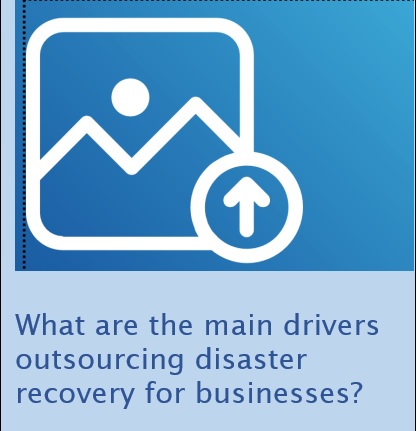Don’t let your business experience a Data Disaster
With new threats looming – and the cost of downtime rising in terms of productivity, reputation and dollars – businesses of all sizes are rethinking their IT disaster recovery strategies, including the implementation of a Disaster Recovery as a Service (DRaaS) solution.
|
Disaster Recovery Managed Services When was the last time you lost power and/or the internet crashed? What was the impact to your business? Did you lose any data or revenue? The truth is that everyday system outages and cyberattacks are shockingly common. When something bad like this happens, it’s not only frustrating, but it can also be devastating to your bottom line. That’s why it’s important to prepare for any IT disruption. |
|
|
Disaster can strike a business at any moment Your business is at risk every day. Your company needs to keep operations up and running; no matter what; but some things are beyond your control. Storage fails, files get lost, power blacks out, and datacenters go offline. It happens, but random accidents shouldn’t impact your business. Simple daily backups are no longer enough to ensure your business can keep systems up and running in the event of disaster. If disaster does strike, how can you ensure that your business and its technology have the resilience to protect data and are able to recover quickly? |
|
|
Calculate the cost of downtime The fact of the matter is that no business is immune from downtime, whether at the hands of Mother Nature, employee error, or even a cybercriminal. These factors can be applied to calculate actual downtime cost per hour. Bottom line? Downtime risks losing big money for your business. What are the main drivers outsourcing disaster recovery for businesses? When was the last time you lost power and/or the internet crashed? What was the impact to your business? Did you lose any data or revenue? The truth is that everyday system outages and cyberattacks are shockingly common. When something bad like this happens, it’s not only frustrating, it can be devastating to your bottom line. That’s why it’s important to prepare for any IT disruption |
|
Calculating the cost of Downtime
| Lost Revenue | Lost Productivity | Cost to recover | Intangibles |
|
If your business is down, it simply cannot generate revenue. Consider your company’s gross annual revenue and calculate that per hour. |
The cost of downtime increases when your employees are unable to work or are forced to perform non-revenue related activities. |
What data was lost? What services and employee time was required to recover lost data? |
Any damage to reputation or brand results in dollars lost. Downtime can cast an unrecoverable shadow over your business |
What is disaster recovery?
Disaster recovery is the practice of anticipating, planning for, surviving, and recovering from a disaster that may affect a business. Disasters can include:
- Cyber-attacks by hackers or malicious insiders
- Natural events like earthquakes or hurricanes
- Failure of equipment or infrastructure, such as a power outage or hard disk failure
- Human error such as accidental erasure of data or loss of equipment
Disaster Recovery Managed Services explained:
What are Disaster Recovery Managed Services? They help you plan, implement and secure your business with the most effective, next generation technologies and expertise. Disaster Recovery Managed Services enable outstanding business continuity and complete protection of your data with backup and disaster recovery in a single solution for your business. We design an environment prepared for the unexpected. We will establish, execute and support your business continuity strategy by ensuring your business is up and running even in the event of an unplanned outage. If the worst happens, we can quickly spin up your IT systems in the cloud allowing you to remain operational and avoid costly downtime and data loss. With Disaster Recovery Managed Services you get complete peace of mind knowing you are safeguarding your data, employee productivity, and business.

RPO and RTO: Understanding the differences.

Recovery Point Objective (RPO) and Recovery Time Objective (RTO) are two of the most important aspects of your disaster recovery plan: RPOs refer to the amount of data that can be lost before significant harm to your business occurs. RTO refers to how much time an application can be down without causing significant damage to your business.
What steps will our team take implementing your business’s Disaster Recovery Managed Services?
- Take inventory and define your business’s key assets: We help prioritize your assets; whether business critical, important or noncritical. By doing so, it will help focus on recovering the most vital assets first so that your business can begin functioning again as quickly as possible.
- Help you decide the best recovery window: What period of downtime can your business sustain? Is it within minutes, hours, days? This is done when defining your RTO and RPO.
- Define your recovery solution: We will help determine the best way to replicate your data between multiple disaster recovery sites.
- Test the disaster recovery solution and thereafter manage and maintain it: Even backups can fail in a disaster, so its paramount to test your replicated data and ensure it can be restored back to your business’s site. We repeat this step periodically to ensure the setup is working.
Next steps:
To learn more about our Disaster Recovery Managed Services, contact us:
Tri-Paragon Inc.
By phone +1 343 800-0246
By email roy.bartlett@triparagon.com
Tri-Paragon’s Cyber protection tools are powered by Acronis Cyber Protect.









